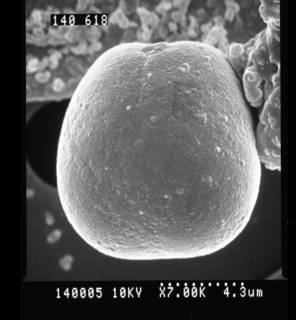WoRMS taxon details
Ostreopsis heptagona D.R.Norris, J.W.Bomber & Balech, 1985
233707 (urn:lsid:marinespecies.org:taxname:233707)
accepted
Species
marine, fresh, terrestrial
Norris, D. R.; Bomber, J. W.; Balech, E. (1985). Benthic dinoflagellates associated with ciguatera from the Florida Keys. I. Ostreopsis heptagona sp. nov. <em>In: Toxic Dinoflagellates (Ed. by D.M. Anderson, A.W. White & D.G. Baden), pp. 39-44. Elsevier Science Publishing.</em> [details] Available for editors  [request]
[request]
LSID urn:lsid:algaebase.org:taxname:49565
Description Relatively large cells, broadly ovoidal, tapering ventrally in apical viewPlate 1’ peculiar and heptagonal, i.e. having a...
LSID urn:lsid:algaebase.org:taxname:49565 [details]
Description Relatively large cells, broadly ovoidal, tapering ventrally in apical viewPlate 1’ peculiar and heptagonal, i.e. having a...
Description Relatively large cells, broadly ovoidal, tapering ventrally in apical viewPlate 1’ peculiar and heptagonal, i.e. having a suture with 5’’, which is not present in other species. Plate 2’ small, about twice the size of Po. Cingulum very narrow (1.5–3.0 μm). Sulcus recessed and hidden, transversally elongated. Plate 2’’’’ long, and broadest ventrally. Theca ornamented with many small protuberances containing a pore (0.30 μm in diameter, Faust et al. 1996). An heptagonal plate 1’ has also been found in cultures of O. ovata (Besada et al. 1982) in an aberrant specimen, and more recently in a strain of O. cf. ovata by Penna et al. (2010). Although these species are much smaller in size than O. heptagona, the heptagonal shape of the 1’ plate is not an unambiguous character to identify this species. [details]
Guiry, M.D. & Guiry, G.M. (2024). AlgaeBase. World-wide electronic publication, National University of Ireland, Galway (taxonomic information republished from AlgaeBase with permission of M.D. Guiry). Ostreopsis heptagona D.R.Norris, J.W.Bomber & Balech, 1985. Accessed through: World Register of Marine Species at: https://www.marinespecies.org/aphia.php?p=taxdetails&id=233707 on 2024-11-21
Date
action
by
2006-07-28 07:22:01Z
created
Camba Reu, Cibran
Copyright notice: the information originating from AlgaeBase may not be downloaded or replicated by any means, without the written permission of the copyright owner (generally AlgaeBase). Fair usage of data in scientific publications is permitted.
original description
Norris, D. R.; Bomber, J. W.; Balech, E. (1985). Benthic dinoflagellates associated with ciguatera from the Florida Keys. I. Ostreopsis heptagona sp. nov. <em>In: Toxic Dinoflagellates (Ed. by D.M. Anderson, A.W. White & D.G. Baden), pp. 39-44. Elsevier Science Publishing.</em> [details] Available for editors  [request]
[request]
basis of record Gómez, F. (2005). A list of free-living dinoflagellate species in the world's oceans. <em>Acta Bot. Croat.</em> 64(1): 129-212. [details]
additional source Guiry, M.D. & Guiry, G.M. (2024). AlgaeBase. <em>World-wide electronic publication, National University of Ireland, Galway.</em> searched on YYYY-MM-DD., available online at http://www.algaebase.org [details]
additional source Tomas, C.R. (Ed.). (1997). Identifying marine phytoplankton. Academic Press: San Diego, CA [etc.] (USA). ISBN 0-12-693018-X. XV, 858 pp., available online at http://www.sciencedirect.com/science/book/9780126930184 [details]
ecology source Hansen, P. J.; Tillmann, U. (2020). Mixotrophy in Dinoflagellates: Prey Selection, Physiology and Ecological Importance in Dinoflagellates: Classification, Evolution, Physiology and Ecological Significance. <em>Ed: Subba Rao Durvasula. Publisher: Nova Science Publishers, Inc. New York, USA.</em> [details]
ecology source Mitra, A.; Caron, D. A.; Faure, E.; Flynn, K. J.; Leles, S. G.; Hansen, P. J.; McManus, G. B.; Not, F.; Do Rosario Gomes, H.; Santoferrara, L. F.; Stoecker, D. K.; Tillmann, U. (2023). The Mixoplankton Database (MDB): Diversity of photo‐phago‐trophic plankton in form, function, and distribution across the global ocean. <em>Journal of Eukaryotic Microbiology.</em> 70(4)., available online at https://doi.org/10.1111/jeu.12972 [details]
ecology source Faust, M. A.; Morton, S. L.; Q, J. P. (1996). Further SEM studies of marine dinoflagellates: the genus Ostreopsis (Dinophyceae). <em>J. Phycol.</em> 32: 1053-1065. [details]
basis of record Gómez, F. (2005). A list of free-living dinoflagellate species in the world's oceans. <em>Acta Bot. Croat.</em> 64(1): 129-212. [details]
additional source Guiry, M.D. & Guiry, G.M. (2024). AlgaeBase. <em>World-wide electronic publication, National University of Ireland, Galway.</em> searched on YYYY-MM-DD., available online at http://www.algaebase.org [details]
additional source Tomas, C.R. (Ed.). (1997). Identifying marine phytoplankton. Academic Press: San Diego, CA [etc.] (USA). ISBN 0-12-693018-X. XV, 858 pp., available online at http://www.sciencedirect.com/science/book/9780126930184 [details]
ecology source Hansen, P. J.; Tillmann, U. (2020). Mixotrophy in Dinoflagellates: Prey Selection, Physiology and Ecological Importance in Dinoflagellates: Classification, Evolution, Physiology and Ecological Significance. <em>Ed: Subba Rao Durvasula. Publisher: Nova Science Publishers, Inc. New York, USA.</em> [details]
ecology source Mitra, A.; Caron, D. A.; Faure, E.; Flynn, K. J.; Leles, S. G.; Hansen, P. J.; McManus, G. B.; Not, F.; Do Rosario Gomes, H.; Santoferrara, L. F.; Stoecker, D. K.; Tillmann, U. (2023). The Mixoplankton Database (MDB): Diversity of photo‐phago‐trophic plankton in form, function, and distribution across the global ocean. <em>Journal of Eukaryotic Microbiology.</em> 70(4)., available online at https://doi.org/10.1111/jeu.12972 [details]
ecology source Faust, M. A.; Morton, S. L.; Q, J. P. (1996). Further SEM studies of marine dinoflagellates: the genus Ostreopsis (Dinophyceae). <em>J. Phycol.</em> 32: 1053-1065. [details]
From editor or global species database
LSID urn:lsid:algaebase.org:taxname:49565 [details]From regional or thematic species database
Description Relatively large cells, broadly ovoidal, tapering ventrally in apical viewPlate 1’ peculiar and heptagonal, i.e. having a suture with 5’’, which is not present in other species. Plate 2’ small, about twice the size of Po. Cingulum very narrow (1.5–3.0 μm). Sulcus recessed and hidden, transversally elongated. Plate 2’’’’ long, and broadest ventrally. Theca ornamented with many small protuberances containing a pore (0.30 μm in diameter, Faust et al. 1996). An heptagonal plate 1’ has also been found in cultures of O. ovata (Besada et al. 1982) in an aberrant specimen, and more recently in a strain of O. cf. ovata by Penna et al. (2010). Although these species are much smaller in size than O. heptagona, the heptagonal shape of the 1’ plate is not an unambiguous character to identify this species. [details]Harmful effect There are no records of toxin production by this species in nature. However, when originally described from Florida (Norris et al. 1985), cultured cells showed limited toxicity based on the mouse bioassay [details]



